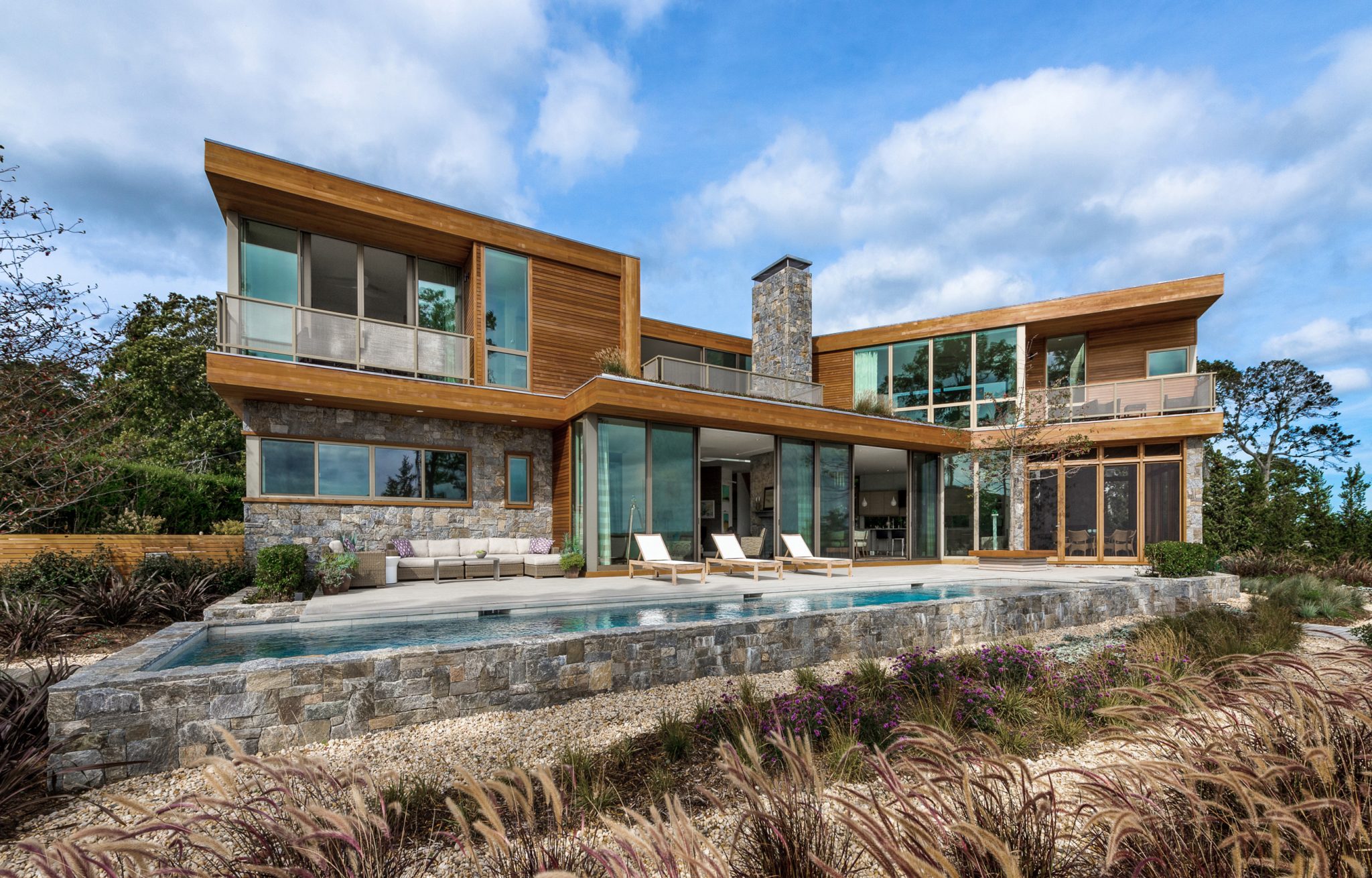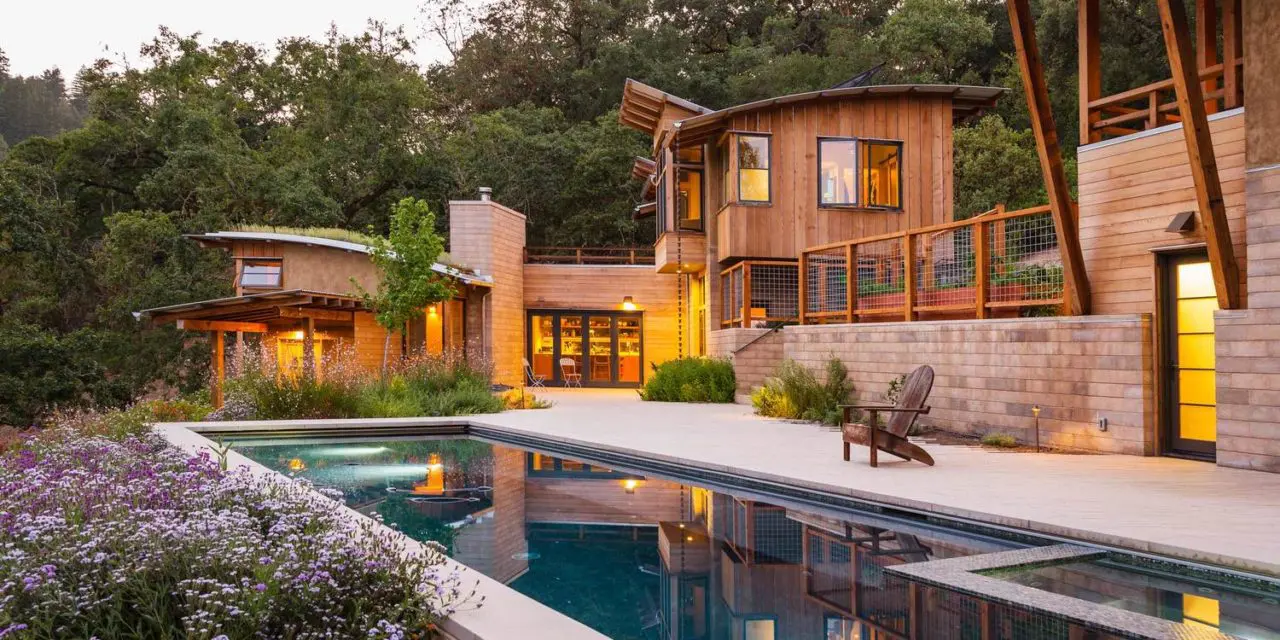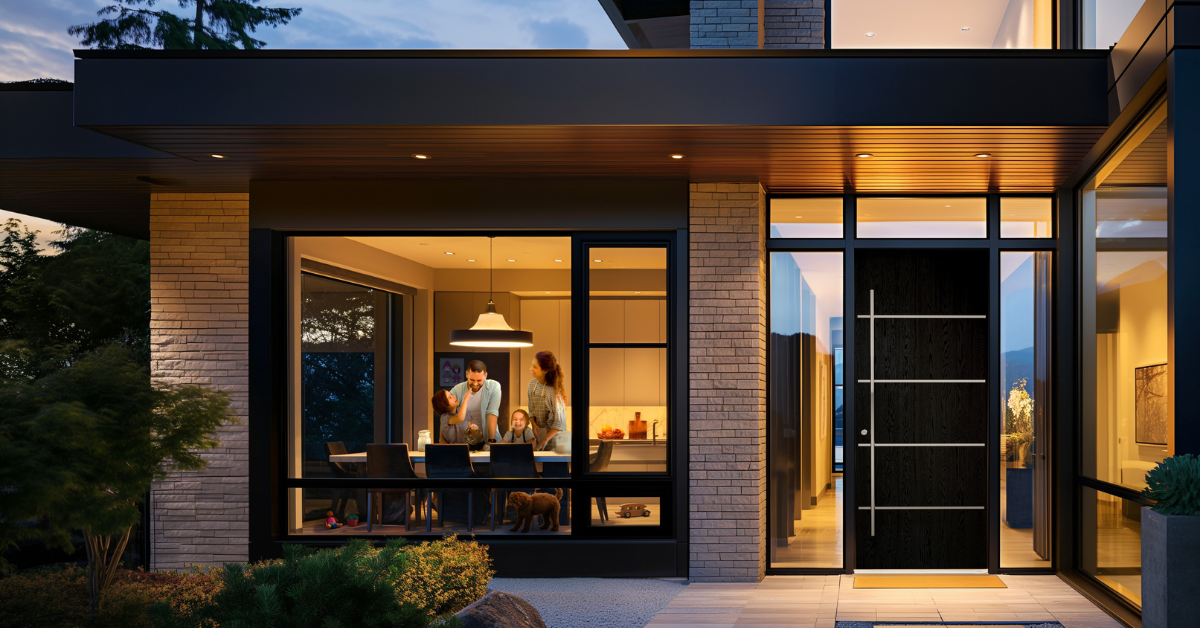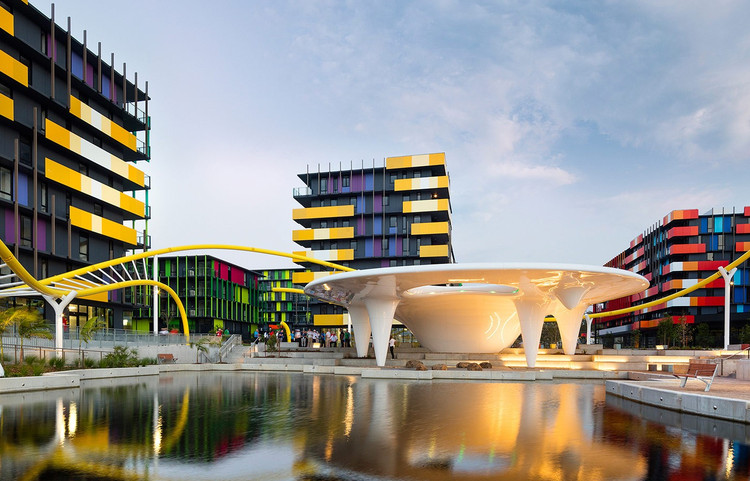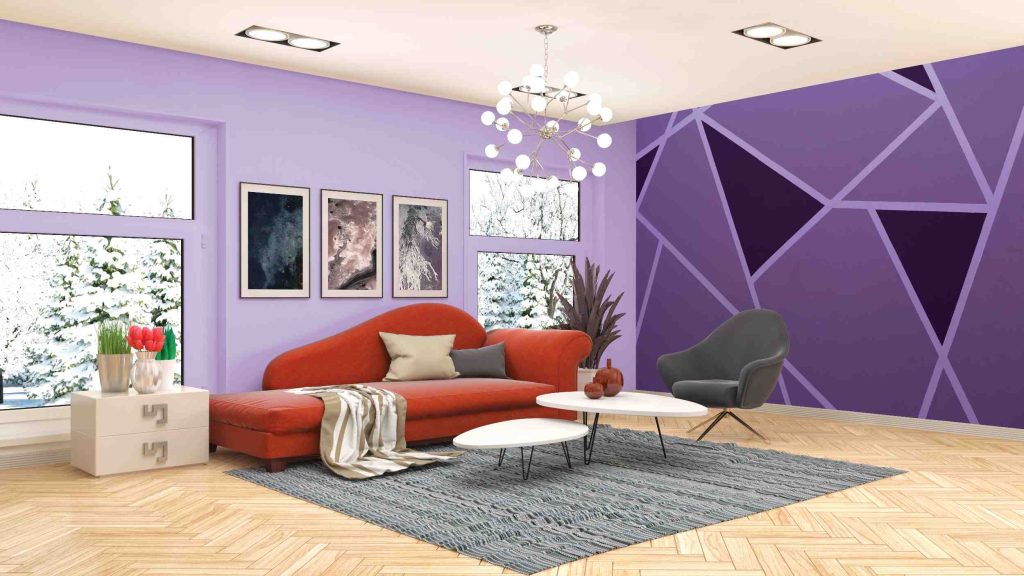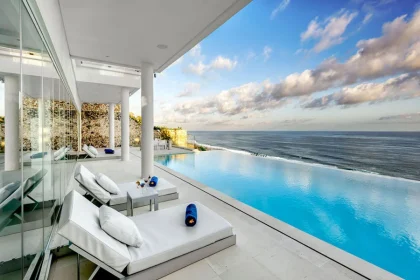Fallingwater is one of the most well-known houses in the world, created by the famous American architect Frank Lloyd Wright in 1935. It was built on top of a waterfall in a quiet part of Pennsylvania, and it is considered a real gem of 20th-century architecture. What makes Fallingwater special is not just how beautiful it looks, but also how it shows a powerful idea of bringing homes into harmony with nature.
This article takes a closer look at the history, design, and lasting influence of Fallingwater House. It also talks about the advantages of Wright’s way of thinking about architecture and shows examples of products that were inspired by this famous design. By the end, you’ll have a full picture of why Fallingwater is still admired so much and how its ideas are still relevant today.
The History of Fallingwater
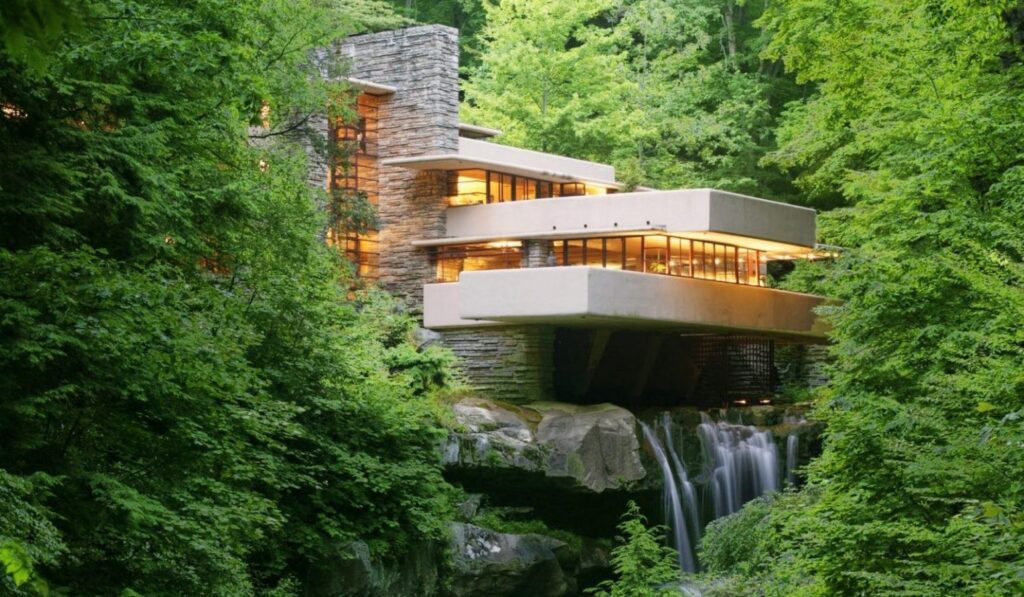
www.dailyartmagazine.com
The Commission and Frank Lloyd Wright’s Vision
In the middle of the 1930s, Edgar J. Kaufmann, a rich businessperson from Pittsburgh, wanted a quiet place to get away from the city. He asked Frank Lloyd Wright, a famous architect known for his creative ideas, to build him a house in the state of Pennsylvania. Wright had not made a big project in a while, but he was still well-known for his unique ways of designing buildings.
Kaufmann thought the house should be built where he could see the waterfall on Bear Run. But Wright had a different plan. He decided to build the house right above the flowing water. This surprising choice shocked Kaufmann and showed how Wright believed in blending buildings with nature, making homes feel like they were part of the natural world.
Construction and Engineering Challenges
The building of Fallingwater started in 1936 and was finished in 1939. It wasn’t an easy project. The terraces that stuck out over the waterfall were a big engineering challenge. Workers doubted whether the concrete could support that kind of weight, and even Frank Lloyd Wright’s designs had to be checked again during the building.
Even with all the hard work, Fallingwater stayed strong and became one of Wright’s biggest successes. In the years since, it has been restored and fixed up to keep it safe, but its original look and bold ideas are still there.
Architectural Design and Features
Organic Architecture in Practice
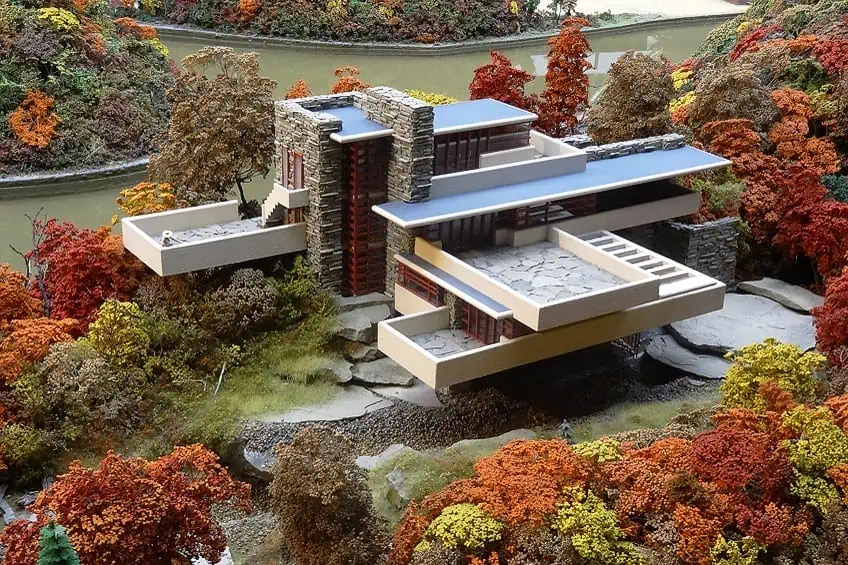
artfilemagazine.com
Fallingwater is the best example of Wright’s idea about organic architecture, where a building feels like it naturally grows from the land it’s on. The house uses stones from the local area for its walls, making it look like it’s part of the rocky surroundings. Large glass windows let in wide views of the forest, and the sound of the waterfall is a natural part of the living space.
This way of designing changed how people think about buildings and nature. Wright believed buildings shouldn’t take over or change the land. Instead, they should fit with it. Fallingwater shows this idea of balance and connection perfectly.
Cantilevered Terraces and Structural Innovation
The most famous part of Fallingwater is its set of cantilevered terraces. These thick concrete slabs stick out from the house with no support visible underneath, making it look like the building is floating above the waterfall.
This big structural decision was really new and exciting back then. It broke away from usual building styles and showed how much Wright was ready to try new ideas with modern technology. Now, the cantilevers of Fallingwater are used as examples in architecture classes to show how creative and brave engineering can be.
The Interior of Fallingwater
Living Spaces Connected to Nature
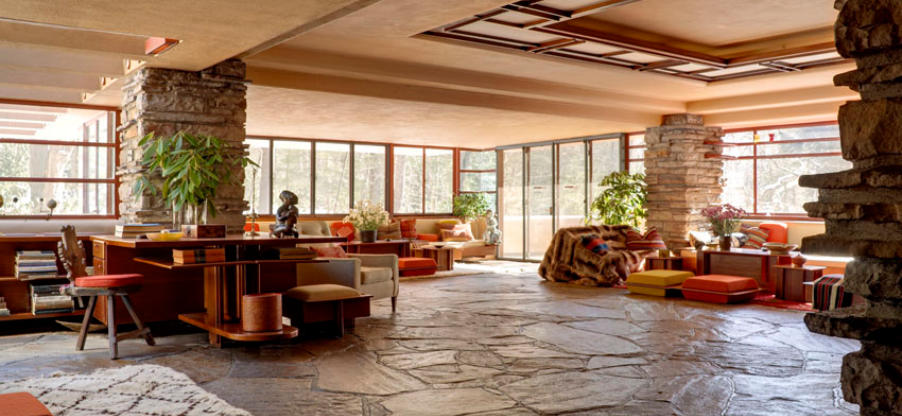
fallingwater.org
Inside Fallingwater, the connection to nature continues. The main living room features stone floors that appear to extend directly from the surrounding rock. Built-in furniture and low ceilings emphasize intimacy while still allowing for open views through expansive windows. Even the fireplace incorporates a natural boulder from the site, merging the indoors with the outdoors.
Every detail was carefully considered by Wright to ensure the occupants felt immersed in the environment. This attention to natural integration makes the interior feel like an extension of the landscape itself.
Innovative Design Details
Wright incorporated numerous innovations into the interior. Instead of traditional furniture, he designed built-in seating and storage, creating a seamless flow in each room. Staircases lead directly from the living spaces to the stream below, further strengthening the connection between daily life and the natural setting.
The use of open floor plans, natural lighting, and multi-level designs made Fallingwater a precursor to many modern architectural trends that would dominate later in the 20th century.
Benefits of Fallingwater’s Design Philosophy
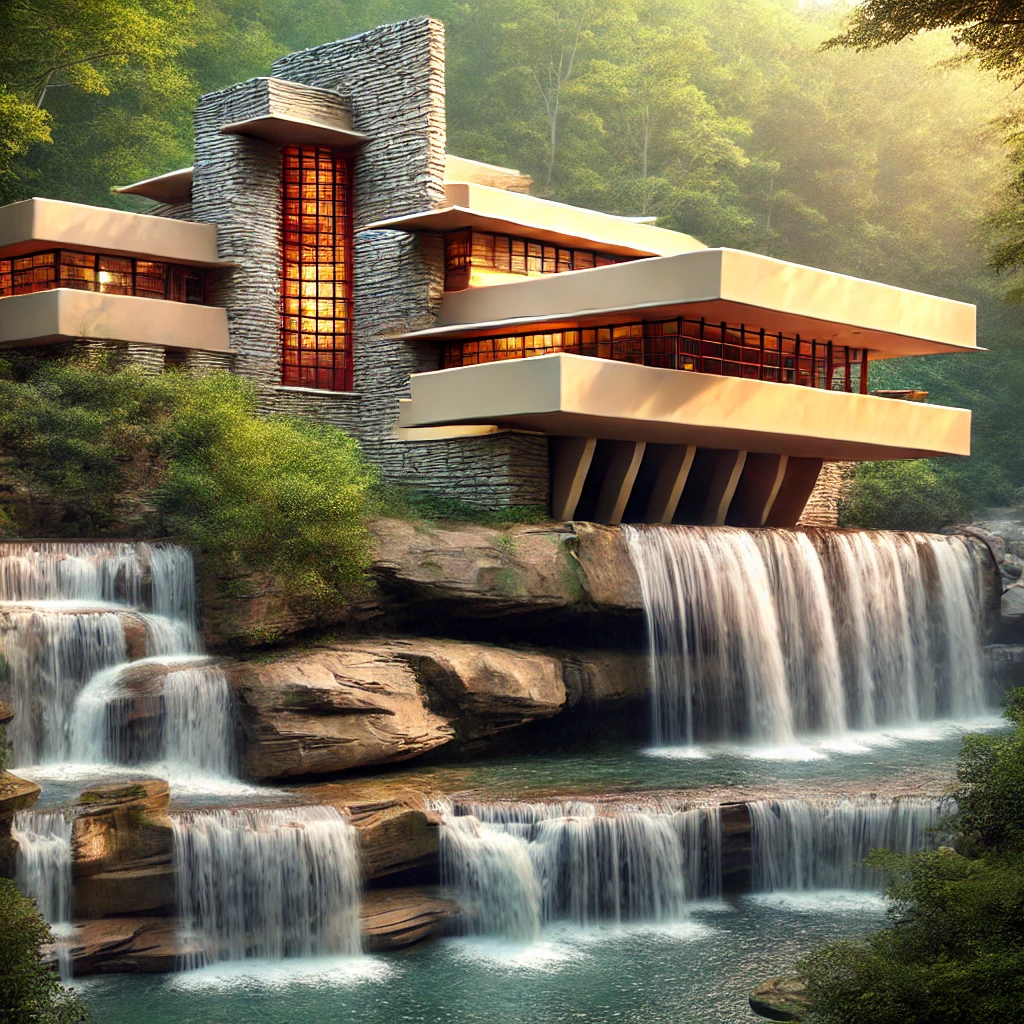
i0.wp.com
Living in Harmony with the Environment
One of the key benefits of Fallingwater is its demonstration of living in harmony with nature. In a world increasingly dominated by urbanization and artificial spaces, Wright showed that homes could coexist with natural landscapes without destroying them.
For residents and visitors, this connection with nature provides a sense of calm, reduces stress, and promotes mental well-being. The soothing sound of water, combined with natural light and views of the forest, creates an environment that nurtures both body and spirit.
Inspiration for Sustainable Architecture
The design principles behind Fallingwater continue to inspire sustainable architecture today. Concepts like using local materials, maximizing natural light, and designing buildings to complement the landscape have become central to green building practices.
Fallingwater’s influence can be seen in modern eco-homes, passive houses, and architectural projects that prioritize environmental harmony. Wright’s philosophy remains relevant as society seeks solutions to climate change and urban overdevelopment.
Real-World Products Inspired by Fallingwater
LEGO Architecture Fallingwater
The LEGO Architecture series once featured a detailed replica of Fallingwater. This collectible set allowed enthusiasts to recreate Wright’s masterpiece in miniature form. The model captured the iconic cantilevered terraces and integration with natural surroundings.
The product was not only a fun building activity but also an educational tool for architecture students and design lovers. By constructing the model, users gained insights into Wright’s structural choices and his philosophy of balance with nature.
Taschen’s Fallingwater Book
Several publishers, including Taschen, have released comprehensive books dedicated to Fallingwater. These books include high-quality photography, original sketches, and detailed commentary on Wright’s vision.
Such publications serve as valuable resources for architecture students, historians, and enthusiasts who want to explore the deeper meaning and technical achievements of Fallingwater. Reading these works allows people to appreciate not only the beauty of the house but also the genius behind its creation.
Fallingwater Souvenir Art Prints
Visitors and admirers can purchase art prints of Fallingwater that capture its serene beauty. These prints, created by artists and photographers, often emphasize the harmony between the house and its surrounding landscape.
Owning such artwork allows individuals to bring a piece of architectural history into their homes. Beyond decoration, these prints act as daily reminders of the importance of design that respects and embraces nature.
Frank Lloyd Wright-Inspired Lighting
Lighting designs inspired by Frank Lloyd Wright often feature geometric patterns and natural materials that echo the themes of Fallingwater. These lamps and fixtures combine functionality with artistry, embodying Wright’s belief that every element of a home should be both useful and beautiful.
Such lighting products are popular among homeowners who want to incorporate organic architectural principles into modern interiors. They demonstrate how Wright’s vision continues to influence contemporary design.
Documentaries on Fallingwater
Several documentaries explore Fallingwater’s history, construction, and cultural impact. These films allow audiences who cannot travel to Pennsylvania to experience the house virtually. They often include expert commentary, rare archival footage, and interviews with architects inspired by Wright.
Documentaries provide educational value and help viewers understand why Fallingwater is regarded as one of the greatest buildings of the 20th century.
Frank Lloyd Wright-Inspired Furniture
Furniture collections inspired by Wright’s designs reflect his emphasis on clean lines, natural materials, and functional beauty. Chairs, tables, and cabinets designed in his style bring the spirit of Fallingwater into modern living spaces.
These pieces solve a common problem in interior design: balancing style with functionality. Wright-inspired furniture not only looks timeless but also provides practical use, aligning with his philosophy that good design must serve everyday life.
Visiting Fallingwater
Fallingwater is located in Mill Run, Pennsylvania, about 90 minutes southeast of Pittsburgh. Today, it is managed by the Western Pennsylvania Conservancy and operates as a museum open to the public. Guided tours are available that allow visitors to explore the interior, terraces, and surrounding grounds while learning about the house’s history and significance.
Visiting Fallingwater is often described as a transformative experience. The opportunity to stand on the terraces, hear the rush of the waterfall below, and walk through spaces designed to merge seamlessly with nature provides insights into Wright’s genius that no book or photograph can fully capture.
How to Buy Products Related to Fallingwater
For those who wish to experience Fallingwater’s legacy in their own lives, various inspired products are available. LEGO models, architecture books, souvenir prints, Wright-inspired lighting, documentaries, and furniture collections provide different ways to engage with the design philosophy.
Each product serves a purpose beyond decoration or entertainment. They offer educational opportunities, aesthetic beauty, and practical solutions for incorporating organic design into modern life. By purchasing these items, admirers can bring elements of Wright’s vision into their homes and daily routines.
FAQ
What makes Fallingwater House by Frank Lloyd Wright so important?
Fallingwater is significant because it embodies Wright’s philosophy of organic architecture, designing buildings that exist in harmony with nature. It also pushed architectural boundaries with its daring cantilevered terraces and remains a cultural icon of 20th-century design.
Can people stay overnight at Fallingwater?
No, Fallingwater is not a residence today. It is preserved as a museum and UNESCO World Heritage Site. Visitors can take guided tours and explore the property during open hours.
How can I bring Fallingwater-inspired design into my home?
You can incorporate elements such as natural materials, geometric forms, and open spaces. Products like Wright-inspired lighting, furniture, and artwork allow you to integrate the spirit of Fallingwater into your living environment.


